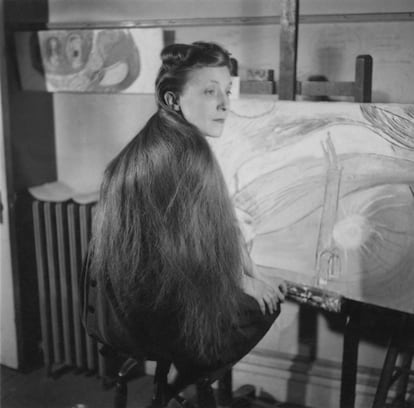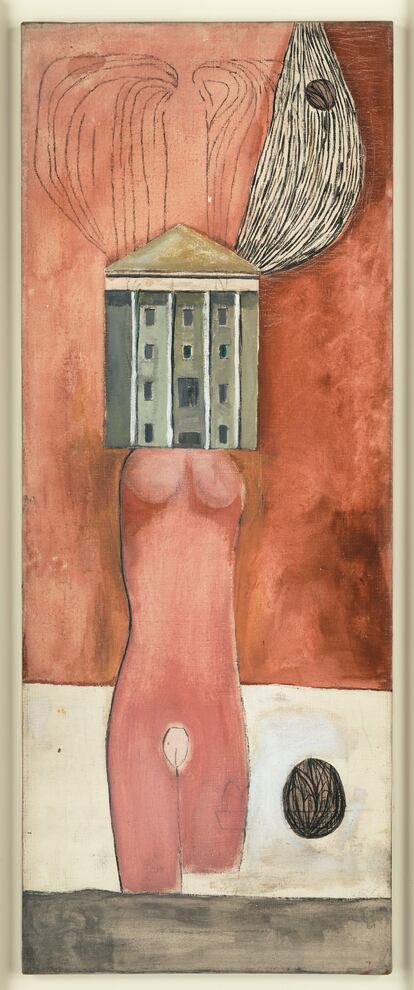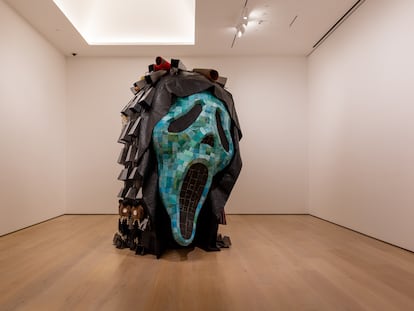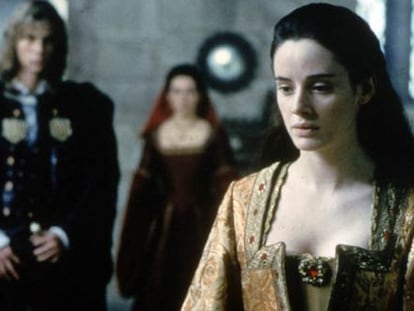Louise Bourgeois in Vienna: The webs of the ‘spider woman’
For the first time in Europe — at the Belvedere Museum in Vienna — a major retrospective dedicated to the pictorial work of the French-American sculptor is now on display

Louise Bourgeois (1911-2010) is one of the artists who defined sculpture in the 20th century. Known for her monumental spider bronzes — which have been installed at the doors of temples such as the Tate Modern in London, the Hermitage in Saint Petersburg, the Guggenheim in Bilbao and now the Belvedere Museum in Vienna — the origin of her visual imagination came from her oil paintings. Through her canvases, the artist expressed the essential forms and personal demons that she would explore over the course of seven decades. The Belvedere has now brought these works together, to exhibit them for the first time in Europe in a retrospective titled Persistent Antagonism.
Bourgeois was born in Paris, on Christmas Day in 1911. At the age of 26, she got married to the famous art critic Robert Goldwater. They moved to New York City, where she began to paint and express her anxieties through art to exorcise them. “Despite her proximity to the surrealists in 1930s Paris and the abstract expressionists in 1940s New York, her work remained predominantly figurative and unconventional,” explains curator Sabine Fellner. Then, all of a sudden, Bourgeois stopped painting.
No one knew her better than Jerry Gorovoy, her confidant and personal assistant for three decades. He often dealt with the petite French-American artist’s fits of rage (“my emotions are inadequate for my size,” Bourgeois once shouted). During the recent exhibition, he discreetly walked through the baroque rooms of the Belvedere. He chairs the Easton Foundation in New York, which manages the creator’s legacy.
So, why did Bourgeois abandon painting? “She abandoned oil on canvas, but she never stopped drawing and making engravings,” Gorovoy clarifies. “She chose sculpture because it was a more physical work… and to dominate the space.”
One of her final works — Cell (The Last Climb), from 2008 — is an installation the size of a room. At the Belvedere, it’s presented between mythological scenes and 18th-century frescoes in the monumental Marble Hall, the only room in the palace that spans two floors. The cells and the spiders (one of which is installed in the gardens of the Belvedere), are the two great emblems of the sculptural work of Bourgeois. In 1982, she became the first female artist to be given a retrospective at the Museum of Modern Art (MoMA) in New York.

Bourgeois’ canvases, created between 1938 and 1949, are exhibited in dialogue with a selection of sculptures, installations, drawings and engravings from a fruitful artistic career that embraces the 20th century. If the cells can be read as a self-portrait, the spider motif (which she first depicted in a small drawing in 1947) is an ode to her mother and a nod to her own creative process. These insects build their worlds from their own bodies: that’s how they create their webs. Bourgeois felt that her art was a physical response to her emotions and anxieties.
Most of the paintings have barely been shown to the public. Some are classics, like The Runaway Girl, or the paintings from the Femme Maison series, which became icons for the second wave of the feminist movement. The exhibition contains the eternal ambiguities of Bourgeois. The loudest was her frontal rejection of the phrase “feminist artist,” which she considered to be a restrictive label. On one of the walls of the Belvedere, next to the painting Roof Song (1947), one of her quotes reads almost like a roar: “There’s no feminist esthetic. Absolutely not! There’s psychological content. I don’t work the way I do because I’m a woman. It’s because of the experiences I’ve gone through.”
In one of those experiences, on December 11, 1970, she protested against the opening of the Annual Exhibition of Contemporary American Sculpture at the Whitney Museum in New York, due to the limited presence of female artists (although she was included). Two years later, she would repeat this protest at the MoMA. Labels were one thing and actions were another. “In her work, Bourgeois reacted to the power relations between men and women and reflected the social role of women in the dominant patriarchal structures at the time,” says Fellner.

In another room, a huge plaster-and-latex penis hangs from a wire. Bourgeois provocatively titled the sculpture Fillette (little girl, in French). “The phallus is the object of my tenderness. It’s about vulnerability and protection,” the artist said in 1968. She was still wearing the same mischievous smile in 1982, when Robert Mapplethorpe photographed her with Fillette clutched under her arm. Bourgeois was 71 and in the prime of her career. She looked at the camera proudly, her face chiselled by wrinkles. There’s a luminous shine in her eyes. It was she — and not Mapplethorpe — who decided that she should pose with the fleshy sculpture of a 24-inch phallus, for a portrait commissioned by MoMA for the retrospective. The 1982 exhibition, which the museum censored, would establish her on the international art scene. In the catalog, the image was framed in such a way that Fillette wasn’t visible. “The shine in my eyes is due to what I carry with me. But they cut it [out of the picture]. They cut it because the museum was so prudish,” she told art historian Mignon Nixon.
Already in the 21st century, another glass ceiling was broken… one that, today, has been sealed again. In 2001, the Hermitage in Saint Petersburg gave Bourgeois the first exhibition dedicated to a living American artist. Shortly afterwards, she exhibited The Reticent Child at Sigmund Freud’s house-museum in Vienna. Bourgeois began undergoing psychoanalysis in 1951 and continued the sessions for years. In the opinion of Johanna Hofer — another curator of the Belvedere exhibition — themes such as lust, desire, sexuality and aggression, all implicit in Femme Maison, gained their explosive force when the artist laid down on the couch.
Bourgeois claimed that pain was her business. “I give meaning and form to frustration and suffering,” she stressed. The notion of classifying Bourgeois as a tormented artist — who expresses her traumas and inner conflicts in the creation of her works — may seem like a cliché. When asked about this, Gorovoy responds with another: “Bourgeois said that happy people don’t have stories.” The main decoder of the artist’s symbolism adds: “She made her problems into art.”
Bourgeois once noted: “If I had been happy, I don’t think I would have been an artist.” She lived until the age of 98.
Sign up for our weekly newsletter to get more English-language news coverage from EL PAÍS USA Edition
Tu suscripción se está usando en otro dispositivo
¿Quieres añadir otro usuario a tu suscripción?
Si continúas leyendo en este dispositivo, no se podrá leer en el otro.
FlechaTu suscripción se está usando en otro dispositivo y solo puedes acceder a EL PAÍS desde un dispositivo a la vez.
Si quieres compartir tu cuenta, cambia tu suscripción a la modalidad Premium, así podrás añadir otro usuario. Cada uno accederá con su propia cuenta de email, lo que os permitirá personalizar vuestra experiencia en EL PAÍS.
¿Tienes una suscripción de empresa? Accede aquí para contratar más cuentas.
En el caso de no saber quién está usando tu cuenta, te recomendamos cambiar tu contraseña aquí.
Si decides continuar compartiendo tu cuenta, este mensaje se mostrará en tu dispositivo y en el de la otra persona que está usando tu cuenta de forma indefinida, afectando a tu experiencia de lectura. Puedes consultar aquí los términos y condiciones de la suscripción digital.
More information
Archived In
Últimas noticias
Welcome to the post-religion era: The idea of Christianity as the absolute truth has become obsolete
‘I thought you would like it’: The risky sexual practice popularized by TV shows and TikTok
The digitalization of tourism: ‘They promise experiences and gave us the worst possible one’
Mexican peso defies uncertainty with forecasts of a new period of stability in 2026
Most viewed
- Sinaloa Cartel war is taking its toll on Los Chapitos
- Reinhard Genzel, Nobel laureate in physics: ‘One-minute videos will never give you the truth’
- Oona Chaplin: ‘I told James Cameron that I was living in a treehouse and starting a permaculture project with a friend’
- Why the price of coffee has skyrocketed: from Brazilian plantations to specialty coffee houses
- Silver prices are going crazy: This is what’s fueling the rally











































